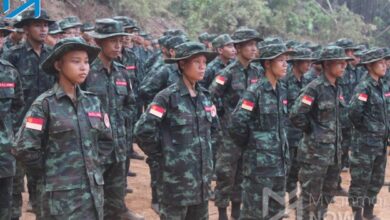
A monk who campaigns for militia groups armed and trained by Myanmar’s military has proclaimed that villages that support the anti-junta resistance must be “erased” from the country’s map.
Videos published by a junta mouthpiece show the monk, named U Warthawa, visiting villages in resistance strongholds such as Sagaing Region’s Kanbalu, Kyunhla and Taze townships. The videos point to his role in supporting the military’s efforts to recruit new militia members.
Over the past year, Myanmar’s coup regime has been organising pro-military locals into militia groups in northwestern and central Myanmar—particularly in Sagaing, where the armed resistance movement has been especially strong.
These groups, known as Pyu Saw Htee, typically accompany soldiers on village raids and in counterattacks on anti-junta People’s Defence Force (PDF) groups and local guerrilla forces.
They often consist of pro-army nationalists, war veterans, and members of the Union Solidarity and Development Party, the military’s proxy party. Despite their presence, however, the resistance forces have managed to maintain a firm foothold in many areas due to continued public support.
In an interview published by a junta propaganda outlet on Sunday, U Warthawa said in response to this situation that communities that financially support anti-regime forces should be eradicated.
“If it is true that some villages are financing them, then we need to teach them a lesson. We will erase those villages from the map of Myanmar. This is something we need to uproot,” he said.
‘On the side of terrorists’
U Warthawa is the abbot of a Buddhist temple in Hmaw Taw, a predominantly Muslim village in Sagaing’s Kanbalu Township. Only around 10% of the village’s roughly 500 households are Buddhist.
Regarded locally as an ultranationalist, he was previously affiliated with Ma Ba Tha, a now-defunct Buddhist extremist group notorious for its attacks on Myanmar’s Muslim community.
In a video dated June 10, he is seen addressing around 80 men and women in camouflage uniforms. Their sleeve badges indicate that they are under the supervision of the military’s Northwestern Regional Command, based in Monywa.
“We have armed everyone around here with all the weapons they need, including bullets,” he is heard saying in the video. He also says that he has been working with military officers to help form other militia groups in the area.
In another video shot on the same day, he is seen in the village of In Phet Taw, about 20km from Hmaw Taw. This time, he combines his pro-militia message with calls to reopen schools—something that the resistance regards as part of the junta’s effort to assert administrative control over the country.
“Reopen the schools and attend this training for the people’s militia. You will be armed lawfully,” U Warthawa says to his audience of nearly 100 men and women as at least four fully-armed soldiers in uniform stand by.
“Sign up for militia training. If you fail to attend the training, it means you are on the side of terrorists,” he continues, using the junta’s preferred term for PDF groups.
Pitting civilians against civilians
In an interview with Myanmar Now on Monday, U Warthawa defended his calls for erasing pro-resistance villages, saying he did so in the spirit of what he called “angry benevolence”.
He only wants what’s best for local people, he said, adding that this also extended to the PDF groups that he labelled terrorists.
“I want them to be good people. The PDFs also belong to our national race,” he said.
The exact number of militias in Myanmar is not known, but according to leaked records of a meeting held in Naypyitaw earlier this year, Sagaing Region’s junta-appointed chief minister, Myat Kyaw, claimed that his region alone had 77 such groups, armed with more than 2,000 weapons.
In his interview with Myanmar Now, Warthawa said that just three townships in the region—Kanbalu, Kyunhla and Taze—now have 4,000 militia members, including around 100 women.
A spokesperson for the Kanbalu PDF confirmed that many villages in the township now have militias, but said that it was unclear how well-armed they are.
“There may be some differences in how well those villages are armed by the military. Some are well-equipped and some are only partially armed,” he said.
Meanwhile, Warthawa contradicted his earlier conciliatory tone towards the PDFs by again echoing the regime’s official line to accuse them of being behind the arson attacks that have been a hallmark of the military’s anti-insurgent campaign in the region.
Resistance forces, and not junta soldiers, were responsible for ransacking and torching thousands of homes in Sagaing and other parts of the country where they are active, he insisted.
A member of the Kyunhla PDF dismissed this claim completely, saying that it was just part of the junta’s effort to turn the people against the armed resistance.
“They are just trying to pit civilians against each other so that they can prolong their dictatorship and cling to power,” he said.


![Resistance fighters holding heavy weapons ammunition in central Myanmar. (Photo: Freedom Revolution Force [FRF])](https://myanmar-now.org/en/wp-content/uploads/sites/5/2024/04/438869056_443267851680128_1706386881626943924_n-390x220.jpeg)
